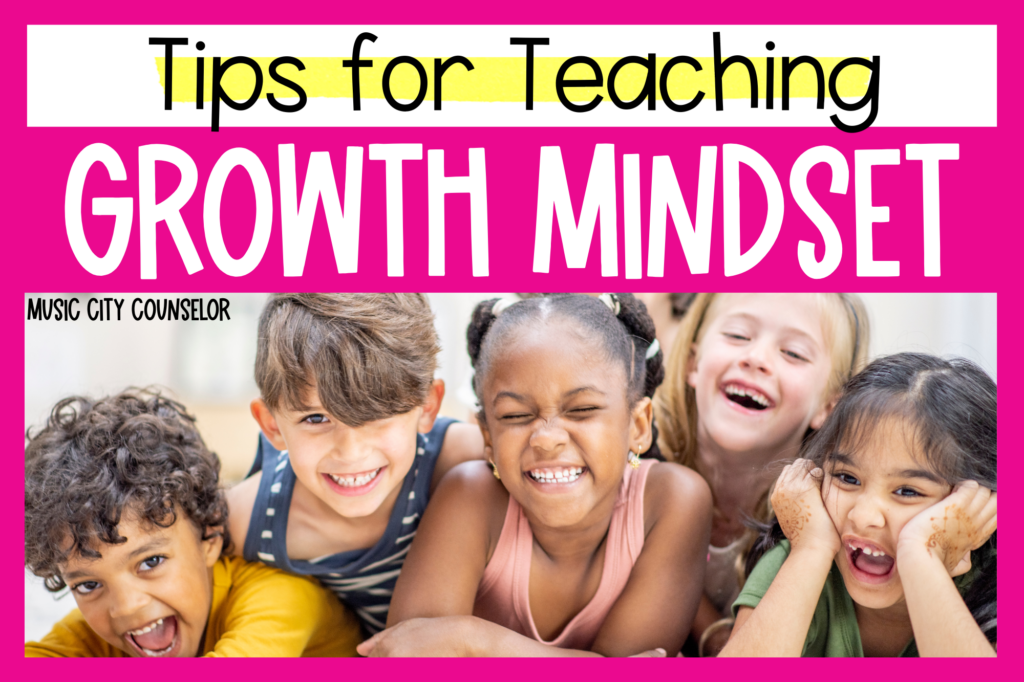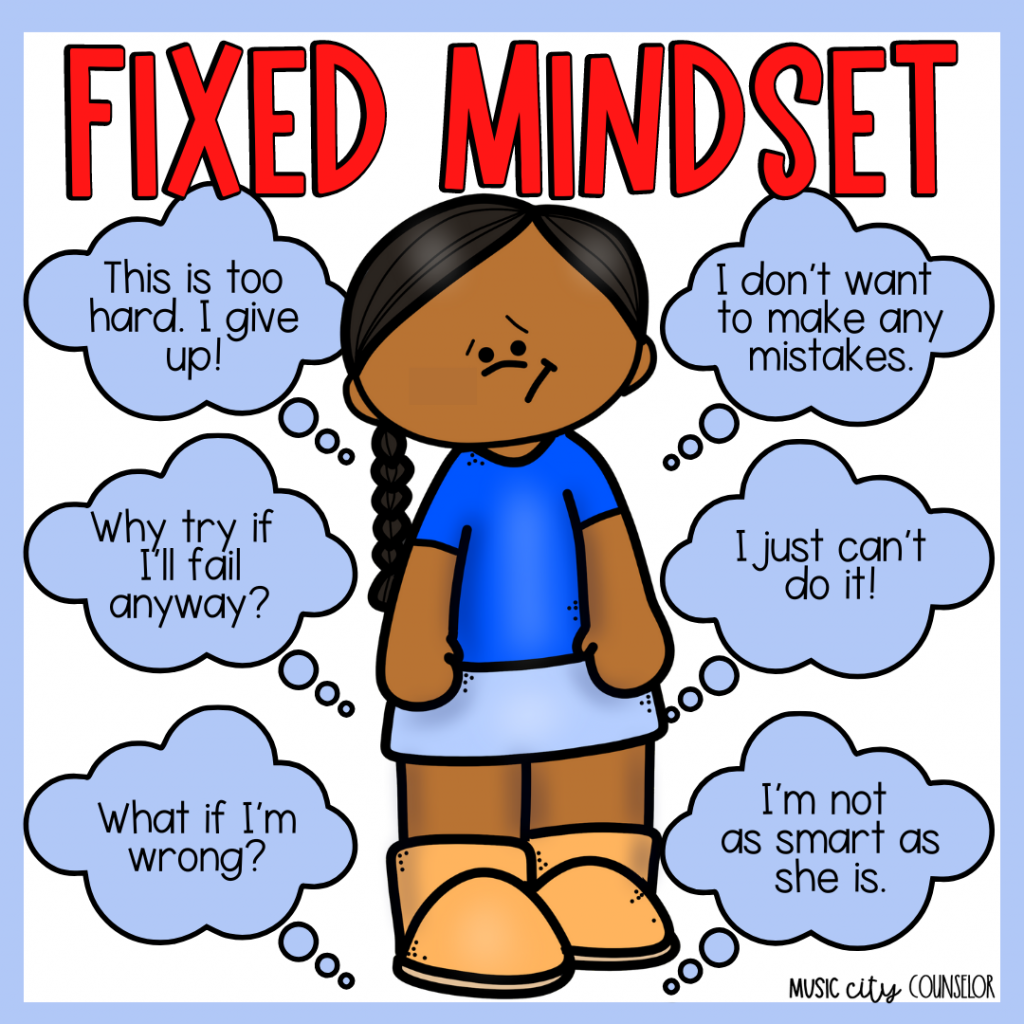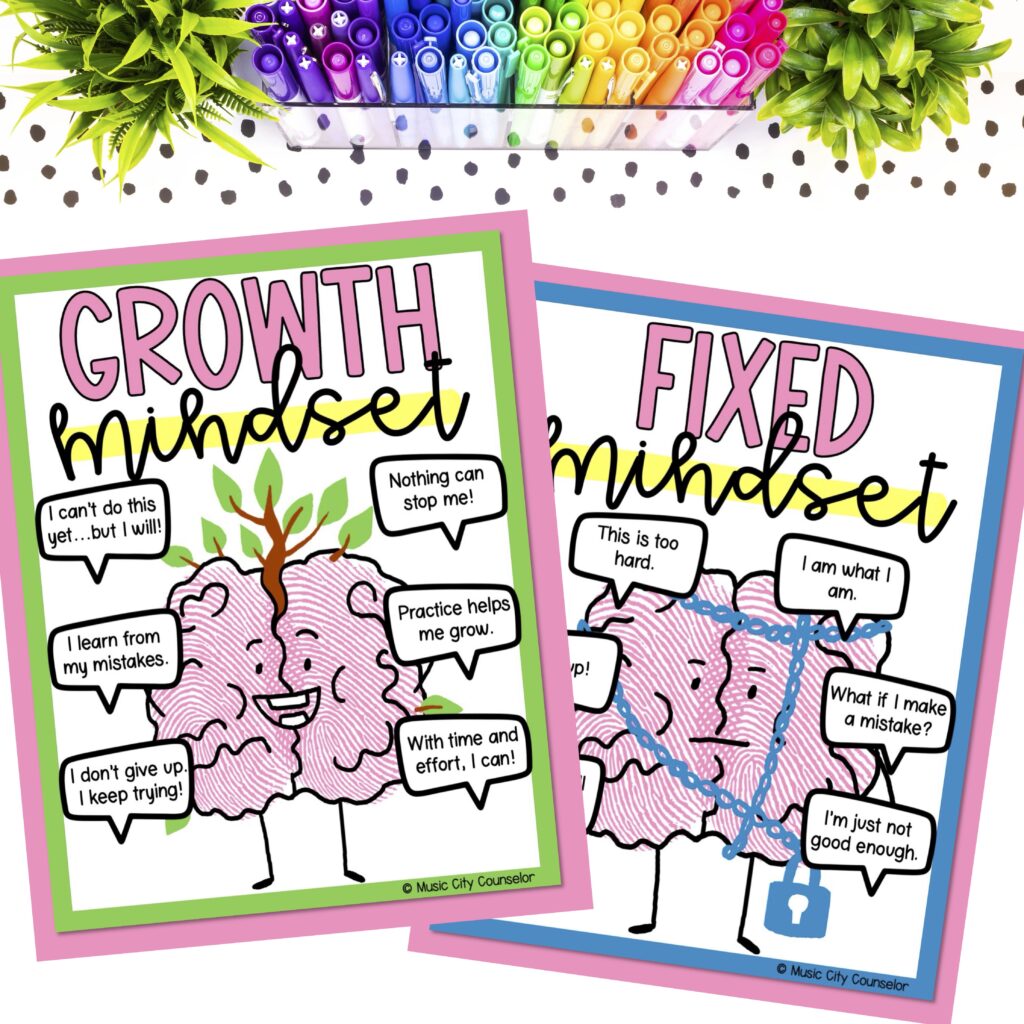
Hey y’all! Thanks so much for stopping by. My name is Laura and I am an Elementary School Counselor turned Curriculum Writer. At my precious school in Nashville, TN, 97% of my students were living in …

Growth mindset, for good reason, has become one of the biggest buzz words and theories in education today. The concept comes from Dr. Carol Dweck’s studies of thousands of children and their attitudes towards failure. In her research, Dr. Dweck noticed that, when faced with failure, some children felt devastated and helpless, and quickly gave up. Other children, on the other hand, seemed to bounce back, learn from their mistakes, and move forward with optimism and hope.
So, what is the difference between these two types of children, and how do these attitudes affect their learning and self-esteem? And how can we encourage students to adopt this more positive and resilient mindset and approach to life?
Our “mindset” is the way we see and think about ourselves. If we have a “growth” mindset, we believe that the abilities, intelligence, skills, and talents we were born with do not determine our success. Instead, we understand that although we were are all born with strengths and weaknesses, through hard work, practice, and learning, we can grow, progress, improve, and get better. Our brains are constantly growing, changing, and adapting as we learn new things.
When we have a growth mindset, we love learning and try to learn something new each day. We understand that making mistakes, taking risks, and failing is how we learn and grow. We are self-confident and believe in ourselves and our abilities. We don’t give up – we are resilient, hard workers who persevere and stay strong when faced with challenges. We move forward quickly when we make a mistake or fail.
We believe in the power of YET: We understand that it can feel frustrating when we are faced with a challenge or feel as though we can’t do something right. The truth is, we just can’t do it…YET! With a little more practice, hard work, and perseverance, we will be able to do it and accomplish our goal!
When we have a growth mindset, we tell ourselves,

Your students will love this adorable Sesame Street video about the “Power of Yet!”
Inside of our brains are millions of cells called neurons. Neurons connect and communicate with each other. They process information from our 5 senses (sight, smell, sound, taste, touch) and control our thoughts, feelings, and movements. The strength and pattern of the connections of the neurons in our brains make up the knowledge, skills, and abilities that we have. When we learn and practice new things, we build new connections between the neurons in our brains and the connections that we already had grow stronger and faster.
Neuroplasticity is the ability of the brain to change through learning, practice, and experience. Since our brain is “plastic” and can change, this means that practice, effort, experience, and learning MATTER and make a physical difference in our brain. Our intelligence, talents, and gifts are not “fixed” – they can change and grow!
If we have a “fixed” mindset, we believe that our qualities and traits are “fixed.” This means that they cannot change. In other words, we were born with certain talents and gifts, and a certain level of intelligence, and we cannot grow, improve, learn, or change with time or practice. Those with a fixed mindset often make excuses for their behavior or performance. For example, if they don’t do well on a test, they may say, “I’m just no good at math” or “I can never learn this, no matter how hard I try.” They may give up easily and lack confidence in themselves and their abilities.
In addition, those with a mixed mindset may compare themselves to others and see themselves as second best or not as good. They may feel less prepared or confident to try new things, take risks, face challenges, or solve problems because they feel they just can’t do it, so why try? They may also feel devastated when they make a mistake or fail and lose their desire to try. You can only imagine the implications this type of mindset and attitude have on the learning process in and out of the classroom!
When we have a fixed mindset, we tell ourselves:

Here are some free posters that you can use to teach this material to your students, and display in your space!

Our mindset, how we think, controls how we feel, how we act, and the choices we make. Having a growth mindset helps us learn and succeed in life in general because we…
Researchers Claro, Paunseku, & Dweck (2016) studied 10th graders in Chile and how their mindset affected their scores on a national achievement test. The results showed that mindset MATTERS – those students with a growth mindset were three times more likely to score in the top 20% on the test, and students with a fixed mindset were four times more likely to score in the bottom 20% on the test.
I hope that this post offered helpful information on the difference between growth mindset and fixed mindset, and why this content can be truly life-changing for students! Have you taught growth mindset to your students? How did they respond to your instruction? Please comment below, I’d love to hear from you!

| Cookie | Duration | Description |
|---|---|---|
| cookielawinfo-checkbox-analytics | 11 months | This cookie is set by GDPR Cookie Consent plugin. The cookie is used to store the user consent for the cookies in the category "Analytics". |
| cookielawinfo-checkbox-functional | 11 months | The cookie is set by GDPR cookie consent to record the user consent for the cookies in the category "Functional". |
| cookielawinfo-checkbox-necessary | 11 months | This cookie is set by GDPR Cookie Consent plugin. The cookies is used to store the user consent for the cookies in the category "Necessary". |
| cookielawinfo-checkbox-others | 11 months | This cookie is set by GDPR Cookie Consent plugin. The cookie is used to store the user consent for the cookies in the category "Other. |
| cookielawinfo-checkbox-performance | 11 months | This cookie is set by GDPR Cookie Consent plugin. The cookie is used to store the user consent for the cookies in the category "Performance". |
| viewed_cookie_policy | 11 months | The cookie is set by the GDPR Cookie Consent plugin and is used to store whether or not user has consented to the use of cookies. It does not store any personal data. |
6 Responses
Great!
Thank you so much, Noha! 🙂
I’m going to be teaching about the readers brain and growth mindset.
That sounds fantastic, Brenda! Best of luck with your lesson! 🙂
Thanks so much for the resource. My son will really grow from this!
You’re so welcome! I’m so glad to hear it, especially as a fellow boy mom! 🙂